Introduction
Rapid technological advances supported the emergence of virtual teams (Batarseh et al., 2017). Virtual teams are defined as a group of individuals geographically dispersed who communicate through technology to perform the tasks of an organization, that is with a common goal (Hassett et al., 2018; Munkvold and Zigurs, 2007). Technology has been having a strong impact on people’s personal lives and professionally, considering the growing number of people who use technological tools to interact with their co-workers (Raghuram et al., 2019).
When the COVID-19 pandemic outbreak hit, social distancing measures were put in place, and legislation was introduced that mandated the practice of telecommuting whenever possible. In this context, information and communication technologies enabled and generalized working anytime and anywhere (Contreras et al., 2020).
We aim at understanding how the COVID-19 pandemic has impacted virtual teams’ research. To perform this objective, we continue the study started by Alaiad et al. (2019). We use the same methodology as the reference article and performed a results analysis of the recent years’ research. We then compare the results obtained during the period from 2019 to 2021 to the data obtained from 2007 to 2018 in the reference article.
Theoretical framework
Compilating several authors’ definitions of virtual teams, it was unanimous that teams are virtual when members are geographically dispersed and work through computer-mediated communication to achieve a common goal of the organization (Bell & Kozlowski, 2002; Beranek & Martz, 2005; Gibson & Gibbs, 2006; Handke et al., 2021; Jarvenpaa & Leidner, 1999; Krishnan, 2018; Martins et al., 2004).
Several advantages of working with VT are parallel to remote work: reduces the need to travel between locations and decreases costs concerning time, money and commuting stress (Kilcullen et al., 2021). At distance work, using VTs also allows companies to hire the best talent regardless of their geographic location (Kilcullen et al., 2021).
However, working virtually with other people, that is communicating through technological communication devices with other people, limits the understanding of the nuances of communication, namely nonverbal, which can create barriers. It also makes it harder to resolve misunderstandings and conflicts (Glikson & Erez, 2020).
Literature highlights several areas that have a substantial impact on performance: trust (Klonek et al., 2021), cohesion (Garro-Abarca et al., 2021), and e-leadership (Baughman, 2019).
Trust within teams is a very important topic because it is associated with better performance among fellow members and is, therefore, an important goal which will help them to succeed at their shared tasks (Klonek et al., 2021).
VT consist of a group of people that probably do not know each other personally, and who are in different geographical locations, and effective communication is needed to achieve the organization’s goals (Handke et al., 2021). Team cohesion is a key element to achieving those goals (Garro-Abarca et al., 2021).
Leading VT presents unique challenges that are related to technological skills, new work patterns, decision styles, building relationships of trust and conflict management, as well as providing the cohesion that makes a set of people a team (Baughman, 2019).
The Role of the Pandemic in the Growth of Virtual Teams
The COVID-19 pandemic led to a mindset change making people more open to working remotely. To reduce the spread of the virus, organizations adopted remote work policies, even for employees who had never worked remotely before putting everyone working on VT (Contreras et al., 2020; Garro-Abarca et al., 2021). Thus, the emergence of the COVID-19 pandemic led to a widespread transition to telework, so organizations suddenly were having massive numbers of VT (Chamakiotis et al., 2021).
Although some organizations already used VT as a competitive differentiator, many others were not prepared for this format, but due to the COVID-19 pandemic, they had to adapt, which accelerated the adoption of VT (de Almeida et al., 2021).
The pandemic seems to have normalized remote work and is seen as a logical work option by the population, forcing companies that want to attract talent to adapt. This explains the exponential growth of virtual teams (Peñarroja et al., 2020).
Methodology
In this article, the systematic review of the literature is used to extend the period of analysis from 2019 to 2021of Alaiad et al. (2019) article, which studies virtual teams from 2007 to 2018. Thus, following the same structure, we divided the process into three phases: (1) review planning, (2) review performance and (3) data extraction and synthesis (Ramey and Rao, 2011).
Review planning
In review planning we identified the research questions and objectives, which are the issues to study.
The research question that grounds this study is: what was the COVID-19 impact on virtual teams’ study?
To deal with this question, this study aims at (1) identifying the main constructs analyzed by VT research from 2019 to 2021, and (2) identifying the differences of constructs studies between the period from 2007 to 2018 to the period from 2019 to 2021.
Conducting the review
This is the research strategy, which refers to the description of the steps performed, that is, the choice of the database, the keywords and the selection rules that will be applied in the search, using the PRISMA (Preferred Reporting Items for Systematic Reviews & MetaAnalyses) model (Gunnell et al., 2022).
Web of Science database was used to collect the data, considering it is a well reputed database which covers quality scientific production within an academic field as sources for this review, as Alaiad et al. (2019).
The keywords used in the search are the following: virtual AND teams; virtual AND collaboration; distributed AND teams; computer-mediated AND teams; virtual team AND collaboration; online AND group (Alaiad et al., 2019).
The inclusion criteria applied aimed at finding the same field as Alaiad et al. (2019), applying to the complementary covid and post-covid period: Studies from 2019 to 2021; Articles from scientific journals and conference proceedings; Books, book chapters, notes and technical reports were not included; English language; Only the “Business Economics” filter was included.
Data extraction and synthesis
This step of the systematic literature review refers to collecting and analyzing retrieved data (Alaiad et al., 2019; Ramey & Rao, 2011).
Data collection extracted 996 articles. After excluding the repetitions, 921 articles remained for the screening process.
Simultaneously and independently, two researchers read the title and abstract of the articles to decide about their inclusion in the study. When reading the abstract and title, whenever there were doubts about the inclusion, the article was signed as ‘not yet decided’ and analyzed in another moment. With this procedure, we aimed at avoiding excluding valuable research (Sampaio and Mancini, 2007). Both screenings were compared and, when they were not in agreement, a third researcher decided if the papers should be included in the study.
A last review to the full paper of the remaining 21 papers allowed to define the final paper list (n=18) and to fill an Excel sheet with the papers that constitute the corpus of this study (Figure 1).
A considerable number of papers were excluded from the final list (880 articles disregarded) in the title and abstract analysis due to not being within the topic that we aimed at in this study. Some of the topics that emerged in large numbers in data collection focused on software development, the perception of teachers/educators during the COVID-19 pandemic, and the perception of virtual teams in the world of online gaming. This happened because the keywords used were quite broad, and several topics emerged that were related to the keywords but not specifically related to the virtual teams’ functioning in the organizational context.
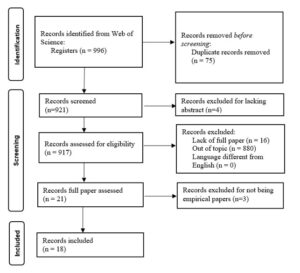
Figure 1: PRISMA diagram
To analyze the data, we organized them into categories. The introductory category collection briefly refers to a simple description of the documents: publication year, type of publication, and keywords. The following category grouping relates to study goals centered on the VTs research topics. To identify the VTs constructs studied between 2019 and 2021, we defined six categories: independent, dependent, moderator, mediator variables, variables assuming more than one type, and studies’ methodological limitations. This allows analyzing the research, as well as comparing to Alaiad et al. (2019) study.
Data Presentation and Analysis
The final corpus of analysis of this study includes 18 documents, with balanced publication years: six in 2019, eight in 2020, and seven in 2021. All 18 papers were published in academic journals. There are three journals that published two papers of this corpus under analysis: Journal of Business Research (Castellano et al., 2021; Richter et al., 2021), Journal of International Management (Jackowska and Lauring, 2021; Taras et al., 2019), and Team Performance Management: An International Journal (Jaakson et al., 2019; Müller and Antoni, 2020). The most mentioned word in the papers’ keywords was teams (n=8), virtual teams, global teams, trust and team performance were equally mentioned (n=4) (Figure 2). (Ben Sedrine et al., 2021; Castellano et al., 2021; Glikson and Erez, 2020; Han et al., 2020; Jaakson et al., 2019; Lin et al., 2019; Müller and Antoni, 2020)
Figure 2: Word cloud of the papers’ keywords
Virtual Teams’ Constructs Studied (2019-2021)
To analyze the constructs studied between 2019 and 2021, we categorized them according to their role in the empirical studies. Such categorization will later allow comparing to the previous period and enlightening this research regarding the evolution of the study on the VT topic during and after the COVID-19 pandemic.
Independent Variables
Among the 18 articles identified published between 2019 and 2021, 20 independent variables were found, and categorized in 9 dimensions: personal characteristics, culture, leadership, dispersion, trust, communication, technology, performance, and training (Table 1).
Cultural intelligence was the most frequently studied independent variable (n=3). VTs bring together people from various cultures who have to interact with each other and collaborate towards a common goal; and for reasons like these, cultural intelligence has become increasingly important because it takes skill to understand and interact with other cultures (Mangla, 2021; Richter et al., 2021; Shaik et al., 2021).
Table 1: Independent variables and their dimensions
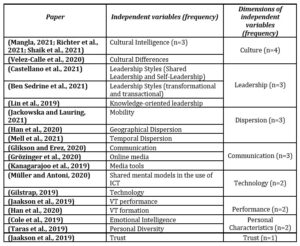
Dependent Variables
Between 2019 and 2021 of the 18 articles identified, 17 dependent variables were studied, and there are 6 macro categories of these variables, namely: collaboration, trust, communication, leadership, contextual diversity, and performance (Table 2).
The dependent variable most studied in the articles under analysis was the one called VT performance (n=7), that is, there were 7 articles whose objective was to understand how to improve the team’s performance based on different independent variables (Table 2).
Although the denomination “performance” appeared in 7 articles, there are additionally 7 other dependent variables in 6 articles that also refer to performance, but with other denominations, totalizing 13 articles, in the total of 18 articles under study. These variables that refer to performance and that have other designations are the following: creative performance of VTs (Grözinger et al., 2020), the effectiveness of VTs (Mangla, 2021), team effectiveness (perceptions of location and the use of knowledge) (Jackowska & Lauring, 2021), project management (Kanagarajoo et al., 2019), interaction and performance of VTs ((Richter et al., 2021) quantity and quality of work and the volume of work (Mell et al., 2021)
Table 2: Dependent variables and their dimensions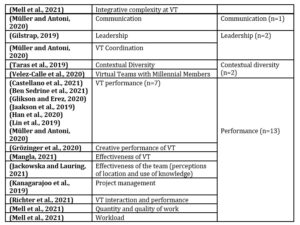
Moderating Variables
Of the 18 articles analyzed, 16 of these articles do not have moderating variables (Ben Sedrine et al., 2021; Castellano et al., 2021; Cole et al., 2019; Gilstrap, 2019; Glikson and Erez, 2020; Grözinger et al., 2020; Han et al., 2020; Jaakson et al., 2019; Kanagarajoo et al., 2019; Lin et al., 2019; Mangla, 2021; Müller and Antoni, 2020; Richter et al., 2021; Shaik et al., 2021; Taras et al., 2019; Velez-Calle et al., 2020).
The moderating variable is a variable that affects the strength and direction of the relationship between the independent variable and the dependent variable (Vieira, 2009). From the analyzed articles, 4 moderating variables emerged, which are: personal context (Jackowska and Lauring, 2021), coordination, workload, and integrative complexity in VT (Mell et al., 2021) (Table 3).
Table 3. Moderating Variables
Mediating variables
In this study, in addition to the moderating variables, articles emerged that studied the mediation relationship, although there were no mediating variables in the reference article, we decided to include it in this study to become more complete.
The mediating variable exerts a relationship of influence between the independent and dependent variables, to reduce the strength of the impact of the independent variable on the dependent variable (Vieira, 2009).
Of the 18 articles, 7 mediating variables emerged: SOAR (strengths, opportunities, aspirations, and results), trust, power and commitment, trust and operational cohesion, collective effectiveness of ICT, trust and effectiveness of the leadership role.
Table 4. Mediating variables
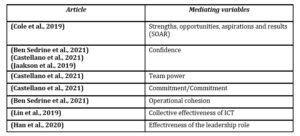
Variables that assume more than one type
Some variables have been studied as independent and dependent and/or intermediate. The trust variable emerges as a dependent variable, but also as an independent and mediating variable (Jaakson et al., 2019). In the same article, the performance variable appears as a dependent and independent variable. This article has several studies and for this reason, presents a complex approach to the investigation of VT. The workload variable, in the article “Bridging Temporal Divides: Temporal Brokerage in Global Teams and Its Impact on Individual Performance,” emerges as a moderating variable, and as a dependent variable (Mell et al., 2021). In the same article, the variable integrative complexity in VT appears as a dependent and moderating variable. This article, as well as the previous one, has several studies, presenting a complex approach to the investigation of VT.
Table 5. Variables that assume more than one type

Studies Methodological Limitations
The identified limitations compromise the internal and external validity of the studies under analysis.
Internal validity refers to the methodological rigor (data collection, sampling, control of variables, etc.) in a given study that impacts the validity of the results of that study (Ollaik and Ziller, 2012).
They used only one member of the group to analyze the team’s behavior. Future research should use the team as a source for analyzing their behavior, not just one member (Cole et al. 2019).
There was no control over the degree of virtuality, and, as some of the team members were from the same country, they may have decided to perform the tasks face-to-face, which may have affected the results obtained (Jaakson et al. 2019).
They used a sample consisting of individual data rather than data from a team to study the shared mental models in ICT use (Müller and Antoni 2020).
Leadership styles and team performance are assessed through self-declarations which is a gap as it leads to the bias of results since participants may underestimate or minimize the actual performance of VTs (Castellano et al., 2021).
External validity refers to the ability to generalize the results of the study and verify that the results are true and reliable (Ollaik and Ziller, 2012).
The samples of the various studies conducted are composed of VT of university students and management/business students from various countries, which makes it difficult to generalize the data because there is variation in the types of cultural school systems and technological environments in which students live (Velez-Calle et al., 2020).
The sample was obtained from Danish organizations which can cause bias in the data because Denmark is a technologically developed country when compared to many other countries. In addition, in Danish companies, work-life balance is important, which can influence how work from home is viewed (Jackowska and Lauring, 2021). Therefore, results cannot be generalized.
Shaik et al. (2021) study is limited to a single organization and four project VTs, through interpretive analysis of surveys, and for this reason, the relationship between cultural intelligence and employee engagement is not generalizable to either the organization or to the general population.
Construct model: comparison between the two periods of analysis
The comparative analysis of the data collected in the guiding study of this work (Alaiad et al., 2019) allows us to perceive the evolution of the constructs that were studied in the scope of VT.
The comparison between the two studies identified many variables that were not recognized in previous studies, that is, the focus of the study of VT is changing.
The variables that appear in both studies are underlined in pink. The variables that appear only in the 2019-2021 study are underlined in blue.
The independent variables that are being studied since 2007, that is, appear in both periods’ (2007-2018 and 2019-2021) studies, are: communication, trust, culture, technology, leadership, and training and dispersion.
The independent variables most studied in the reference article were communication and trust. In this study, the most studied independent variable was cultural intelligence (Mangla, 2021; Richter et al., 2021; Shaik et al., 2021) which emerged more recently and was not mentioned in the baseline study (Alaiad et al., 2019).
The dependent variables researched in both periods are: collaboration, coordination, trust, performance, VT interaction and VT efficacy. Performance was the most studied dependent variable in the base article, which means that, over time, it remains the most frequent interest in studies on VT.
More moderating variables were reported from the reference article than in this study and there are no common moderating variables. In this study, only 4 moderating variables appeared in comparison with the reference article, 16 variables appeared, and no common moderating variables were obtained. In this study, 7 mediating variables emerged, but they were not included in the reference article.
Table 6. Virtual teams’ research constructs conceptual model
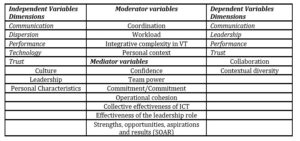
Source: Authors’ own elaboration, based on the variables identified in the research on VT between 2019 and 2021 (for detailed variables and their dimensions see Appendix 1)
Conclusion
With this paper, our goal is gaining insight into the effects of the COVID-19 pandemic on research conducted on virtual teams. Building on the study conducted by Alaiad et al. (2019), focusing on the period between 2007 and 2018, we’ve employed the same systematic literature review methodology and analyzed the research in the following years (2019 to 2021). We then characterize the research on VT performed in these recent years and, finally, compare the findings of the research of both periods, analyzing the evolution of the research on the field.
The systematic literature review began with 996 retrieved articles applying the inclusion criteria. The deeper analysis in the subsequent steps of the process filtered to 18 articles, which constitute the corpus of the study of VTs between 2019 and 2021.
To be able to compare to the reference study and draw an evolution line, we defined the type of variables as the core analysis of the papers: independent, dependent, moderators, mediators, and variables that assume more than one type. This study’s findings offer a conceptual model that synthesizes the key constructs utilized in recent research on virtual teams. The model’s simplicity, based on the dimensions of the constructs, offers an advantage as it also highlights the original variables in case further details are needed.
This paper is centered around a study on virtual teams, which was recently published in the field of business research. The study uncovered that, even though virtual teams have yet to be fully explored in the business field, the pandemic has had a beneficial impact on research in this area.
Virtual teams seem to be still under-studied among management and business research, since in the three years when working based on technology increased exponentially, and, with them, virtual teams constituted by inexperienced people the research on the business field did not focus much on the topic, since only 18 empirical studies were published, distributed in an even way throughout the three years under study. It could be expected to have much more.
Even being published in reputable academic journals, indexed by the Web of Knowledge database, studies displayed some methodological limitations referring to internal validity, that is the methodological rigor compromising the validity of the results of the study, and external validity, compromising the generalization of the results. This kind of flaws appears in underdeveloped fields of research.
After the pandemic, a wider range of independent and dependent variables emerged when researching VTs. Additionally, between 2019 and 2021, the studies on VT that we analyzed incorporated more moderating variables than those reported in the reference article. Notably, there were no common moderating variables across the studies. Moreover, our research identified the emergence of mediating variables, which further enriched the conceptual model. These findings suggest that the field of VT is evolving towards more complex studies and a deeper understanding of the processes involved in virtual teamwork.
By providing a clear and comprehensive overview of virtual teams’ functioning, the conceptual model presented in this study can serve as a valuable framework for future studies in this area for researchers and a useful guide for practitioners alike.
Acknowledgment
This work is financed by Portuguese national funds through FCT – Fundação para a Ciência e Tecnologia, under the project UIDB/05422/2020.
Bibliography
- Alaiad, A., Alnsour, Y., & Alsharo, M. (2019). Virtual Teams: Thematic Taxonomy, Constructs Model, and Future Research Directions. IEEE Transactions on Professional Communication, 62(3), 211–238. https://doi.org/10.1109/TPC.2019.2929370
- Batarseh, F. S., Usher, J. M., & Daspit, J. J. (2017). Collaboration Capability in Virtual Teams: Examining the Influence on Diversity And Innovation. International Journal of Innovation Management, 21(04), 1750034. https://doi.org/10.1142/S1363919617500347
- Baughman, S. (2019). Promising Practices for Leading Virtual Teams. Journal of Extension, 57(5), 5TOT1.
- Bell, B. S., & Kozlowski, S. W. J. (2002). A Typology of Virtual Teams: Implications for Effective Leadership. Group & Organization Management, 27(1), 14–49. https://doi.org/10.1177/1059601102027001003
- Ben Sedrine, S., Bouderbala, A., & Nasraoui, H. (2021). Leadership style effect on virtual team efficiency: Trust, operational cohesion and media richness roles. Journal of Management Development, 40(5), 365–388. https://doi.org/10.1108/JMD-10-2018-0289
- Beranek, P. M., & Martz, B. (2005). Making virtual teams more effective: Improving relational links. Team Performance Management: An International Journal, 11(5/6), 200–213. https://doi.org/10.1108/13527590510617774
- Castellano, S., Chandavimol, K., Khelladi, I., & Orhan, M. A. (2021). Impact of self-leadership and shared leadership on the performance of virtual R&D teams. Journal of Business Research, 128, 578–586. https://doi.org/10.1016/j.jbusres.2020.12.030
- Chamakiotis, P., Panteli, N., & Davison, R. M. (2021). Reimagining e-leadership for reconfigured virtual teams due to Covid-19. International Journal of Information Management, 60, 102381. https://doi.org/10.1016/j.ijinfomgt.2021.102381
- Cole, M. L., Cox, J. D., & Stavros, J. M. (2019). Building collaboration in teams through emotional intelligence: Mediation by SOAR (strengths, opportunities, aspirations, and results). Journal of Management & Organization, 25(02), 263–283. https://doi.org/10.1017/jmo.2016.43
- Contreras, F., Baykal, E., & Abid, G. (2020). E-Leadership and Teleworking in Times of COVID-19 and Beyond: What We Know and Where Do We Go. Frontiers in Psychology, 11, 590271. https://doi.org/10.3389/fpsyg.2020.590271
- de Almeida, D. A., Neto, A. L., da Silva, L. F., & Penha, R. (2021). Daily Meeting as Solution to Communication Barriers of Virtual Team of Multiple Projects. Risus-Journal on Innovation and Sustainability, 12(4), 91–98. https://doi.org/10.23925/2179-3565.2021v12i4p91-98
- Garro-Abarca, V., Palos-Sanchez, P., & Aguayo-Camacho, M. (2021). Virtual Teams in Times of Pandemic: Factors That Influence Performance. Frontiers in Psychology, 12, 624637. https://doi.org/10.3389/fpsyg.2021.624637
- Gibson, C. B., & Gibbs, J. L. (2006). Unpacking the Concept of Virtuality: The Effects of Geographic Dispersion, Electronic Dependence, Dynamic Structure, and National Diversity on Team Innovation. Administrative Science Quarterly, 51(3), 451–495. https://doi.org/10.2189/asqu.51.3.451
- Gilstrap, C. (2019). Exploring m-leader affordances: Team leaders and mobile technologies. Team Performance Management: An International Journal, 25(1/2), 84–99. https://doi.org/10.1108/TPM-02-2018-0014
- Glikson, E., & Erez, M. (2020). The emergence of a communication climate in global virtual teams. Journal of World Business, 55(6), 101001. https://doi.org/10.1016/j.jwb.2019.101001
- Grözinger, N., Irlenbusch, B., Laske, K., & Schröder, M. (2020). Innovation and communication media in virtual teams – An experimental study. Journal of Economic Behavior & Organization, 180, 201–218. https://doi.org/10.1016/j.jebo.2020.09.009
- Gunnell, K. E., Belcourt, V. J., Tomasone, J. R., & Weeks, L. C. (2022). Systematic review methods. International Review of Sport and Exercise Psychology, 1–25. https://doi.org/10.1080/1750984X.2021.1966823
- Han, S. J., Kim, M., Beyerlein, M., & DeRosa, D. (2020). Leadership Role Effectiveness as a Mediator of Team Performance in New Product Development Virtual Teams. Journal of Leadership Studies, 13(4), 20–36. https://doi.org/10.1002/jls.21677
- Handke, L., Costa, P. L., Klonek, F. E., O’Neill, T. A., & Parker, S. K. (2021). Team perceived virtuality: An emergent state perspective. European Journal of Work and Organizational Psychology, 30(5), 624–638. https://doi.org/10.1080/1359432X.2020.1806921
- Hassett, M. E., Harikkala-Laihinen, R., Nummela, N., & Raitis, J. (2018). Emotions and Virtual Teams in Cross-border Acquisitions. Em L. Petitta, C. E. J. Härtel, N. M. Ashkanasy, & W. J. Zerbe (Eds.), Research on Emotion in Organizations (Vol. 14, pp. 163–187). Emerald Publishing Limited. https://doi.org/10.1108/S1746-979120180000014016
- Jaakson, K., Reino, A., & McClenaghan, P. B. (2019). The space between – linking trust with individual and team performance in virtual teams. Team Performance Management: An International Journal, 25(1/2), 30–46. https://doi.org/10.1108/TPM-03-2018-0024
- Jackowska, M., & Lauring, J. (2021). What are the effects of working away from the workplace compared to using technology while being at the workplace? Assessing work context and personal context in a global virtual setting. Journal of International Management, 27(1), 100826. https://doi.org/10.1016/j.intman.2021.100826
- Jarvenpaa, S. L., & Leidner, D. E. (1999). Communication and Trust in Global Virtual Teams. Organization Science, 10(6), 791–815. https://doi.org/10.1287/orsc.10.6.791
- Kanagarajoo, M. V., Fulford, R., & Standing, C. (2019). The contribution of social media to project management. International Journal of Productivity and Performance Management, 69(4), 834–872. https://doi.org/10.1108/IJPPM-09-2018-0316
- Kilcullen, M., Feitosa, J., & Salas, E. (2021). Insights From the Virtual Team Science: Rapid Deployment During COVID-19. Human Factors: The Journal of the Human Factors and Ergonomics Society, 001872082199167. https://doi.org/10.1177/0018720821991678
- Klonek, F. E., Kanse, L., Wee, S., Runneboom, C., & Parker, S. K. (2021). Did the COVID-19 Lock-Down Make Us Better at Working in Virtual Teams? Small Group Research, 104649642110089. https://doi.org/10.1177/10464964211008991
- Krishnan, S. (2018). Book Review: Cristina B. Gibson and Susan G. Cohen, Virtual Teams That Work: Creating Conditions for Virtual Team Effectiveness. Vision: The Journal of Business Perspective, 22(4), 445–446. https://doi.org/10.1177/0972262918804083
- Lin, C.-P., Chiu, C.-K., & Liu, N.-T. (2019). Developing virtual team performance: An integrated perspective of social exchange and social cognitive theories. Review of Managerial Science, 13(4), 671–688. https://doi.org/10.1007/s11846-017-0261-0
- Mangla, N. (2021). Working in a pandemic and post-pandemic period – Cultural intelligence is the key. International Journal of Cross Cultural Management, 21(1), 53–69. https://doi.org/10.1177/14705958211002877
- Martins, L. L., Gilson, L. L., & Maynard, M. T. (2004). Virtual Teams: What Do We Know and Where Do We Go From Here? Journal of Management, 30(6), 805–835. https://doi.org/10.1016/j.jm.2004.05.002
- Mell, J. N., Jang, S., & Chai, S. (2021). Bridging Temporal Divides: Temporal Brokerage in Global Teams and Its Impact on Individual Performance. Organization Science, 32(3), 731–751. https://doi.org/10.1287/orsc.2020.1406
- Müller, R., & Antoni, C. H. (2020). Scale development and validation of shared mental models of information and communication technology (ICT SMM). Team Performance Management: An International Journal, 26(7/8), 391–407. https://doi.org/10.1108/TPM-03-2020-0025
- Munkvold, B. E., & Zigurs, I. (2007). Process and technology challenges in swift-starting virtual teams. Information & Management, 44(3), 287–299. https://doi.org/10.1016/j.im.2007.01.002
- Ollaik, L. G., & Ziller, H. M. (2012). Concepções de validade em pesquisas qualitativas. Educação e Pesquisa, 38(1), 229–242. https://doi.org/10.1590/S1517-97022012005000002
- Peñarroja, V., González-Anta, B., Orengo, V., Zornoza, A., & Gamero, N. (2020). Reducing Relationship Conflict in Virtual Teams With Diversity Faultlines: The Effect of an Online Affect Management Intervention on the Rate of Growth of Team Resilience. Social Science Computer Review, 089443932090757. https://doi.org/10.1177/0894439320907575
- Raghuram, S., Hill, N. S., Gibbs, J. L., & Maruping, L. M. (2019). Virtual Work: Bridging Research Clusters. Academy of Management Annals, 13(1), 308–341. https://doi.org/10.5465/annals.2017.0020
- Ramey, J., & Rao, P. G. (2011). The systematic literature review as a research genre. 2011 IEEE International Professional Communication Conference, 1–7. https://doi.org/10.1109/IPCC.2011.6087229
- Richter, N. F., Martin, J., Hansen, S. V., Taras, V., & Alon, I. (2021). Motivational configurations of cultural intelligence, social integration, and performance in global virtual teams. Journal of Business Research, 129, 351–367. https://doi.org/10.1016/j.jbusres.2021.03.012
- Shaik, F. F., Makhecha, U. P., & Gouda, S. K. (2021). Work and non-work identities in global virtual teams: Role of cultural intelligence in employee engagement. International Journal of Manpower, 42(1), 51–78. https://doi.org/10.1108/IJM-03-2019-0118
- Taras, V., Baack, D., Caprar, D., Dow, D., Froese, F., Jimenez, A., & Magnusson, P. (2019). Diverse effects of diversity: Disaggregating effects of diversity in global virtual teams. Journal of International Management, 25(4), 100689. https://doi.org/10.1016/j.intman.2019.100689
- Velez-Calle, A., Mariam, M., Gonzalez-Perez, M. A., Jimenez, A., Eisenberg, J., & Santamaria-Alvarez, S. M. (2020). When technological savviness overcomes cultural differences: Millennials in global virtual teams. Critical Perspectives on International Business, 16(3), 279–303. https://doi.org/10.1108/cpoib-01-2018-0012
Appendix 1. Conceptual model of Virtual teams’ research












